

|
高雄醫學大學66週年校慶典禮流程 日期:109年10月16日(星期五)上午10:00~12:00 地點 : 國際學術研究大樓B2高醫國際會議中心A廳 |
|
|
活動時間 |
活 動 內 容 |
|
09:30~10:00 |
迎賓 |
|
10:00~10:05 |
典禮開始、唱校歌 |
|
10:05~10:10 |
貴賓介紹 |
|
10:10~10:15 |
鐘育志校長致詞 |
|
10:15~10:20 |
陳建志董事長致詞 |
|
10:20~10:35 |
貴賓致詞 |
|
10:35~10:55 |
頒授名譽博士學位證書-前副總統陳建仁院士 |
|
10:55~11:10 |
合影 |
|
11:10~11:55 |
表揚/頒獎 第24屆傑出校友暨第21屆榮譽校友表揚 感謝108學年度捐資興學人士 109年師鐸獎 109年資深優良教師總統獎 107學年度教學傑出教師 108學年度教學優良教師 108學年度優良教材教師 108學年度績優導師暨輔導老師 108年度傑出論文獎 108年度杜聰明院長青年優秀論文獎 2019年度研究績優教師 109學年度教師研究論文獎勵 108學年度技術移轉類 108學年度專利獲證教師 108學年度產學合作類 全國性創新創業獲獎團隊 資深教職員工暨考績「特優」職員工 |
|
11:55~12:00 |
新進教師介紹 |
|
12:00 |
典禮結束 |
日期 | 項目 | 地點 | |
10/6~10/15(假日除外) | 學生組 | § 跳躍能力(垂直跳) § 敏捷能力(原地快步跑) § 反應能力 | 國際學術研究大樓B1全家商場大廳 |
10/16 13:00開始 | § 速度能力(60公尺) § 速耐力 (女子組800公尺) | 田徑場 | |
10/16 -9:00-11:00 | 教職員組 | § 跳躍能力(垂直跳) § 敏捷能力(原地快步跑) § 反應能力 | 國際學術研究大樓 |
產學技轉成果展 | |||
日期 | 項目 | 地點 | |
10/13-10/16 | 產學技轉成果展 | 國際學術研究大樓 | |
日期 | 項目 | 地點 | |
10/13-10/16 | 109年度大學生研究計畫成果壁報論文競賽 | 第一教學大樓一樓川堂 | |
園遊會 | |||
日期 | 項目 | 地點 | |
10/16 -10:00-17:00 | 園遊會攤位 總計46攤 | 史懷哲大道 | |
日期 | 項目 | 地點 | |
10/17 14:30-16:50 | § 高雄市超越巔峰關懷協會 § 高雄醫學大學聲樂社 § 原鄉學生合唱團表演 (荖濃國小合唱團、寶來國中合唱團) | 第一教學大樓B1 演藝廳 | |
因應大專校院109學年度校園防疫工作,落實本校教職員工生健康監測,進入本校校園之校外人士實聯制及體溫量測。
1. 依據教育部109年9月8日臺教高通字第1090130773號函及本校109年9月21日防疫小組第二十七次會議決議。
2. 本校自109年9月24日起,每週一至週五進行全校出入口管制作業。
|
|
同盟路大門/地停出口 |
自由路大門 |
東側門 |
|
00:00-7:00 |
校外車輛及人員入校,由執勤同仁量溫並登錄。 |
上鎖至5:30 至5:30後採刷卡進出 |
上鎖至5:30 至5:30後採刷卡進出 |
|
7:00-19:00 |
§ 本校教職員工生,請至第一教學大樓川堂處刷卡 § 附院同仁請由地下停車場靠近自由路出口到一樓 § 校外人士入校,由輪值同仁量溫並實聯登錄 |
§ 校外車輛入校,由警衛/保全進行量溫並實聯登錄 § 本校教職員工生,請於自由路警衛室旁刷卡 § 校外人士入校,由輪值同仁量溫並實聯登錄 |
§ 本校教職員工生,請於國研大樓東側川堂刷卡 § 校外人士入校,由輪值同仁量溫並實聯登錄 |
|
19:00-24:00 |
校外車輛及人士由警衛/保全進行量溫並實聯登錄 |
採刷卡進出 |
採刷卡進出 |
3. 請醫研大樓師生同仁,務必先於醫研大樓1F刷卡後進入。
4. 假日校外人士進入校園(同盟路大門),由警衛/保全進行量溫並實聯登錄。自由路大門及東側門關閉,本校教職員工生可刷識別證/學生證進入。
5. 本校教職員工及校外賃居學生一次刷卡後,再次進出校園出入口,請出示安心通行證,即不須再次刷卡;住宿生因進出宿舍須刷卡及登錄體溫,若進入校園出入口,請出示安心通行證,不須再次刷卡。
請教職員工生落實自我健康監測,每天量體溫並上網登錄。
6.請教職員工生落實自我健康監測,每天量體溫並上網登錄。
找到子宮內膜異位症早期發展的關鍵細胞激素–IL-10的雙重角色
[簡介]
子宮內膜異位症是惱人的婦科疾病,生育年齡的婦女約有6–10%的人患有此病,主要症狀是經痛、性交疼痛與不孕,治療後又很容易復發,是很不容易治癒的婦科疾病◦
[迷路的內膜組織]
這種百年無法解決的婦女疾病,成因到底為何呢?目前最被接受的說法是「經血逆流」理論,婦女每月剝落的子宮內膜組織,有部分可能會逆流回腹腔,此時體內免疫系統的白血球細胞會吞噬清除這些異位組織,這個清除過程會發生短暫且微弱的發炎反應,若這發炎反應能夠調控得當的話,就能順利清除逆流組織而又不產生副作用(強烈發炎),這樣這些異位組織就不會累積、黏附、與生長於腹腔中,變成子宮內膜異位的良性腫瘤,每個月報到的「好朋友」也就不會造成女性的生理與心理負擔。
[失調的發炎反應]
那什麼原因會使清除異位組織的發炎反應失調呢?高醫大孫昭玲副教授研究團隊發現「抗發炎因子IL-10」的濃度過高,可能是重要的原因之一;IL-10是各種發炎反應都會伴隨產生的細胞激素(蛋白質),當腹腔中的白血球在清除迷路的內膜組織時,也會產生適量的IL-10,功能是讓發炎不至於太強烈而傷害自己組織,但是如果IL-10量太高,反而會抑制白血球的吞噬功能而阻礙異位組織的清除,而高醫研究團隊利用小鼠模式與斑馬魚模式,發現IL-10居然還能促進血管的新生成,新生血管會讓幸運躲過攻擊的內膜組織生長於腹腔中,四處流竄與沾黏,最終變成子宮內膜異位瘤,成為婦女生活中的夢靨◦
[IL-10的雙重角色]
異位內膜組織中IL-10量太高,不僅阻礙了異位細胞清除,又促進血管新生成支持異位組織生長,那甚麼白血球會產生IL-10呢? 高醫研究團隊利用小鼠動物模式發現可能類漿性樹突細胞(plasmacytoid dendritic cell)在早期子宮內膜異位瘤生長時,就會產生IL-10支持子宮內膜異位瘤的生長與血管新生,而且在病人第四期子宮內膜異位瘤的病理組織中,也確實發現分泌IL-10的類漿性樹突細胞的蹤跡。
[結語]
我們正進行深入研究釐清類漿性樹突細胞在這疾病早期發展時的角色,還有哪些環境汙染物會影響免疫細胞產生IL-10的能力,希望將來能針對這複雜疾病提供預防與新的治療方法。
圖形摘要
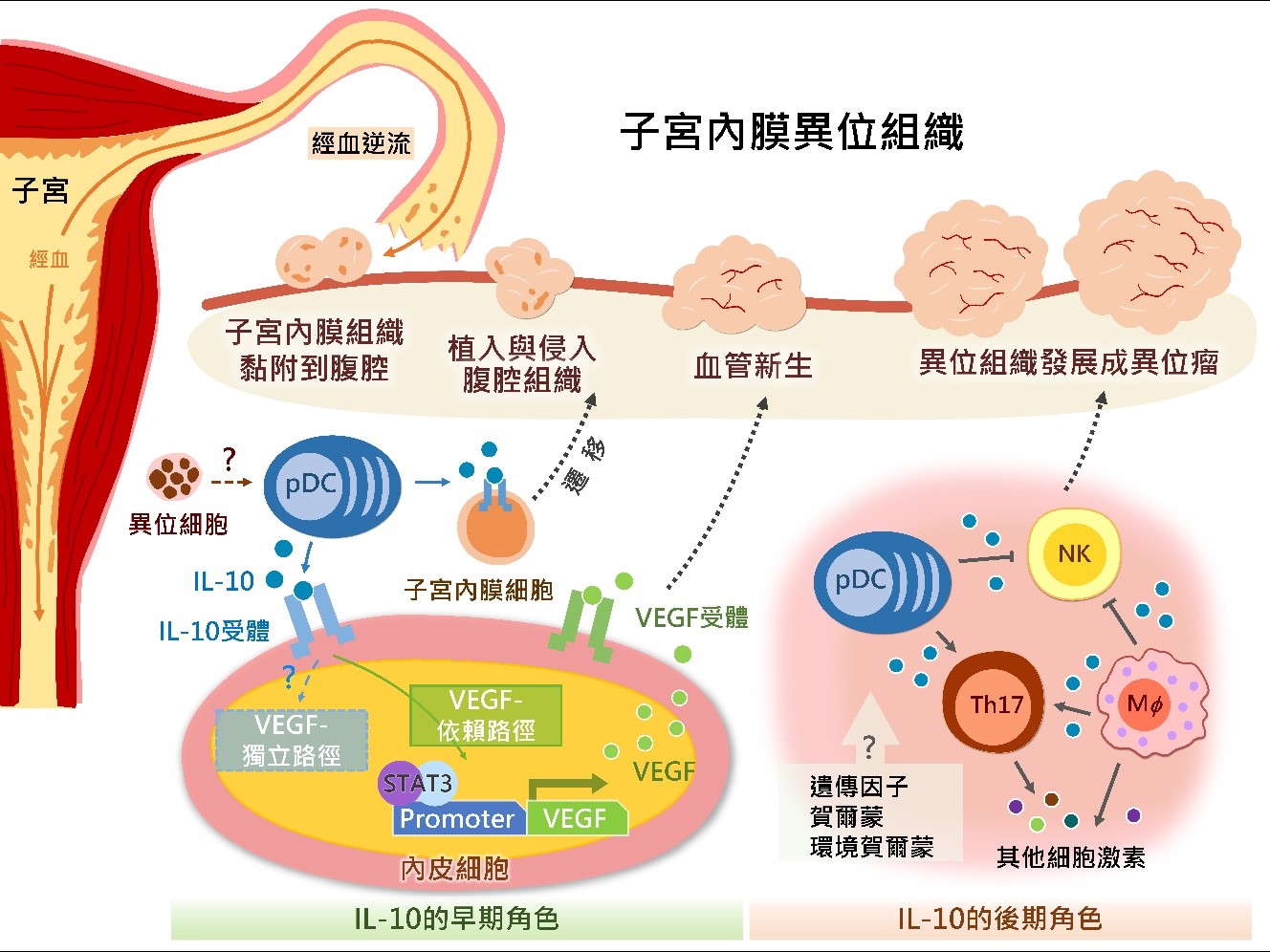
圖說:月經週期時部分子宮內膜組織會逆流回腹腔,內膜組織內的免疫細胞–類漿性樹突細胞(pDC)可能在清除異位細胞時產生IL-10,若IL-10產量太高,會促進子宮內膜細胞遷移與血管新生,這可能奠定了早期異位瘤的發展,異位瘤長大後就有多種免疫細胞也會產生IL-10,而過多的IL-10使得疾病惡化快速,進入後期的發展,病人多在此時出現症狀並就醫治療。(本圖修改自Suen et al. J Pathol. 2019 Dec;249(4):485-497.)
本校主要研究者之簡介:
1. 高醫大醫研所孫昭玲副教授為本研究第一作者,研究領域為先天免疫細胞在過敏性氣喘的調控角色,近年也探究慢性發炎促進子宮內膜異位瘤癌化的免疫機制◦
2. 高醫大醫研所蔡英美教授為本研究責任作者,不只為高醫婦產科主治醫師,專長生殖醫學,也長期從事內膜異位症機制研究。
3. 高醫大生化學科侯自銓教授為本研究共同責任作者,專攻泌尿腫瘤與血管新生機制研究。
研究聯繫Email:jlsuen@kmu.edu.tw
期刊出處: J Pathol. 2019 Dec;249(4):485-497. doi: 10.1002/path.5339.
Popular Science Format in Academic and Research Column
[Introduction]
Endometriosis is a chronic inflammation-associated and common benign gynecological disorder. It affects 6–10% of women of reproductive age with syndromes, including dysmenorrhea, dyspareunia, and infertility. Because endometriosis recurrence following conservative surgery is relatively high, it substantially affects patients’ daily activities.
[Lost way of endometrial tissue]
What is the pathogenesis of endometriosis? The wildly accepted hypothesis nowadays is the “retrograde menstruation/transplantation theory. The endometrial tissue shed during the menstrual cycle flow from the uterus into the peritoneal cavity. The retrograded cells or tissue are cleared by white blood cells. During this process, it would locally happen mild and transient inflammation in peritoneal cavity. If the process between clearance and inflammation keeps balance, the ectopic endometrial tissue can be effectively cleared and the inflammation would not damage the tissue in peritoneal cavity. Therefore, the lost-way endometrial tissue would not become endometriotic tumor and disturb daily activity in women of reproductive age.
[Dysregulated inflammation]
What might disturb the balance between clearance and inflammation when retrograde tissue loses its way into peritoneal cavity? The research team led by Dr. Jau-Ling Suen at Kaohsiung Medical University discovered that the high local activity of anti-inflammatory cytokine IL-10 may promote the growth of the endometriotic tissue. It has been demonstrated that IL-10 can control unwanted inflammation to avoid tissue damage; however, high activity or level of IL-10 may inhibit the functions of white blood cells and diminish the clearance of ectopic tissue. In addition, Dr. Suen and her colleges discovered that IL-10 can promote angiogenesis through IL-10R signaling in vitro and in vivo, including a murine model as well as a zebra fish model. Thus, the IL-10-mediated angiogenesis may promote the growth of endometriotic lesions through enhancing angiogenesis during the early stage of endometriosis.
[The dual activity of IL-10]
These findings discovered by Dr. Suen’s team suggest that the dual functions of IL-10 with respect to suppressing immunity against unwanted cells and promoting angiogenesis in the microenvironment may substantially contribute to the development of endometriosis. The next question is which immune cell type can secrete IL-10 in the microenvironment, particularly during the early stage of disease? Using a surgery-induced endometriosis murine model, Dr. Suen’s team demonstrated that local plasmacytoid dendritic cell (pDC), a key innate cell type in viral immunity, can secrete IL-10 to enhance angiogenesis in and promote growth of endometriotic lesions. In addition, IL-10–secreting pDCs have been found in the human endometrioma tissues, in which higher percentages of cells express IL-10 receptor and angiogenic marker CD31 compared with the corresponding normal counterparts.
[Conclusion]
We continue to put effort in elucidating the pathogenic role of IL-10–secreting pDCs and developing strategy targeting the IL-10–IL-10 receptor pathway in the endometriotic milieu.
Graphical Abstract
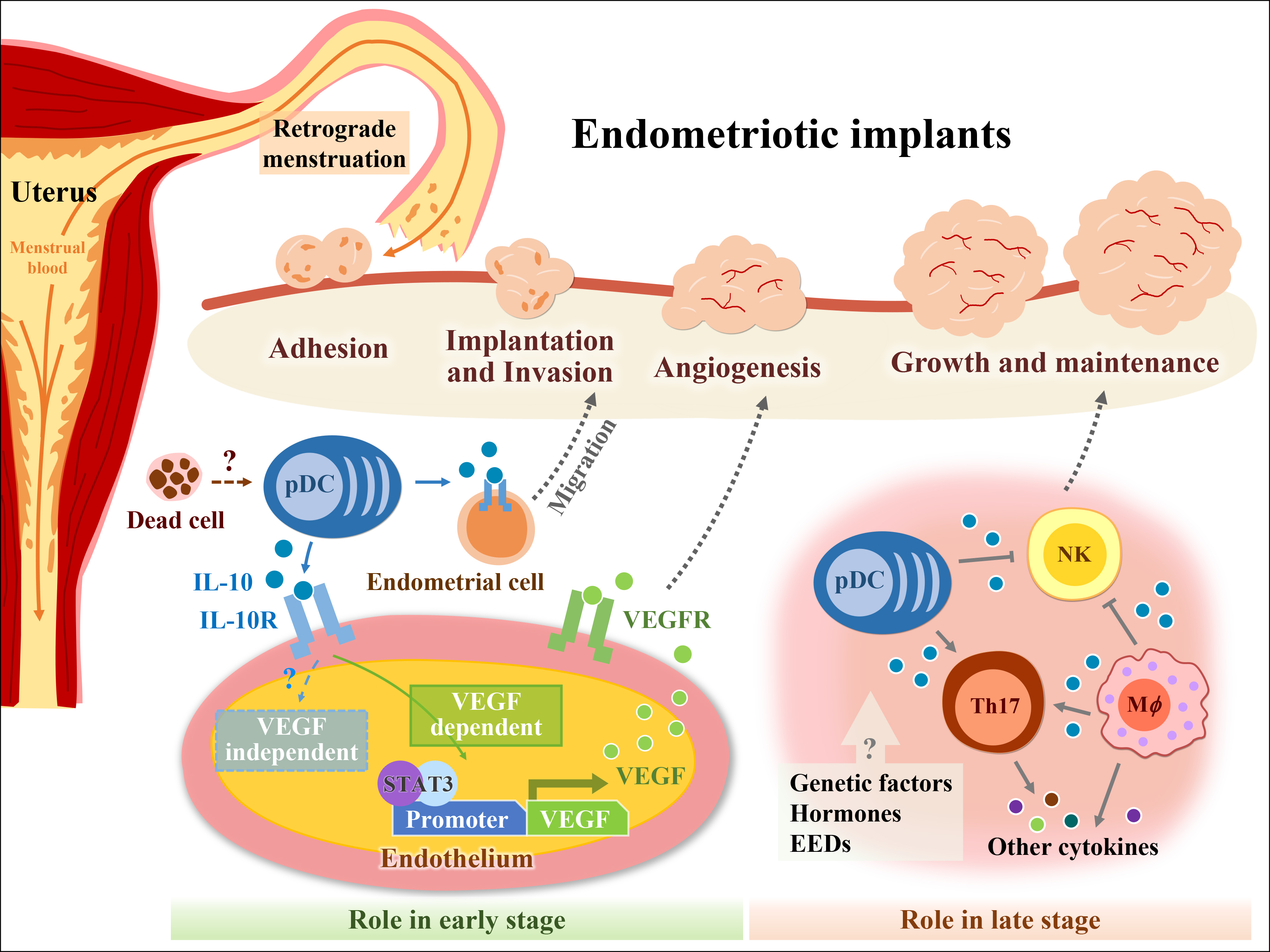
Figure. The cartoon shows the effect and immune cell sources of IL-10 during the early and late stages of endometriosis. During the menstrual cycle and the early stage of endometriosis, retrograded endometrial cells or tissue enter peritoneal cavity. Lesion plasmacytoid dendritic cells (pDCs) may produce IL-10 in response to unwanted cells. Local IL-10 further promotes lesion growth by either suppressing anti-ectopic fragment immunity or stimulating angiogenesis. During the late stage of disease, the complex interaction among genetic factors, endogenous hormones, environmental endocrine disruptors (EEDs), and impaired immune surveillance leads to chronic inflammation. In the context of chronic inflammation in the peritoneal cavity, other immune cells can secrete IL-10 and other mediators to further promote the growth and maintenance of ectopic implants. [The figure is cited from Suen et al. 2019. (J Pathol. 2019 Dec;249(4):485-497)]
Main researcher Intro.
1. Dr. Jau-Ling Suen, the first author, at Kaohsiung Medical University study the role of innate immune cells in the pathogenesis of allergic asthma and endometriosis.
2. Dr. Eing-Mei Tsai, the corresponding author, a gynecologist and reproductive endocrinologist, at Kaohsiung Medical University Hospital. She has devoted in the mechanistic study in endometriosis.
3. Dr. Tzyh-Chyuan Hour, the equally contributed corresponding author, at Kaohsiung Medical University focus on the mechanistic study in prostate cancer and angiogenesis.
Author Email
Paper cited from: J Pathol. 2019 Dec;249(4):485-497. doi: 10.1002/path.5339.
Paper online website: https://pubmed.ncbi.nlm.nih.gov/31418859/
口腔癌篩檢效益評估-學術研究與國家政策實務的連結
口腔癌是國人常見的十大癌症之一,在我國男性常見癌症發生部位更高居第五位,且我國口腔癌的平均發生年齡為55歲左右,比全世界口腔癌平均發病年齡足足早了10年,我國口腔癌好發於青壯年男性,發病後對家庭乃至於整體社會的影響甚鉅;且早期的口腔癌的治療預後相當良好,不僅五年存活率可達到8成以上,治療後對生活品質的影響亦相對較小,因此對口腔癌的防治上,如何發現早期口腔癌個案則是我國衛生單位相當關注的重點。
何佩珊副教授、王文岑醫師及楊奕馨教授團隊研究利用現存的國家級資料庫- 癌症登記系統、口腔癌篩檢資料庫及全國死因登記檔等三個資料庫進行統整,並經由統計模式進行分析,得到以下結果:1. 若單純針對有無參與篩檢來進行比較,發現有參與篩檢及沒有參與篩檢的口腔癌個案的癌症分期並沒有太大差異;2. 若進一步依據篩檢結果分析發現,篩檢發現口腔癌前病變的個案,之後被確診為口腔癌時,其癌症分期有較高的比例是屬於早期的診斷;綜合以上結果,我們提出一個重要結論,要提升口腔癌的篩檢效益的重點除了要鼓勵口腔癌高危險群民眾進行篩檢外,篩檢時若能對口腔癌前病變病灶做比較準確地辨別,使得口罹患腔癌前病變的個案能有機會做進一步的追蹤確診,對於提升我國口腔癌篩檢政策的效益較有幫助。本研究結果發表後,亦將本研究的結論提供我國口腔癌篩檢政策面的回饋,強調口腔癌篩檢時發現口腔癌前病變的重要性,我國國民健康署亦因此特別在口腔強篩檢策略中,強調篩檢口腔癌前病變的重要性並擬訂提升篩檢口腔癌前病變的準確度的相關策略。
本篇研究論文-“Finding an oral potentially malignant disorder in screening program is related to early diagnosis of oral cavity cancer-Experience from real world evidence.”由何佩珊副教授、王文岑醫師及楊奕馨教授團隊發表,在2019年刊登於”Oral Oncology”,該期刊在牙科領域排名為前10%(2017年領域排名為3/91=3.3%),在牙科專業領域上具相當權威性。本篇研究結合我國衛生福利部建置的癌症登記系統、口腔癌篩檢資料庫及全國死因登記檔等三個資料庫進行口腔癌篩檢效益的評估,並提供口腔癌篩檢政策規劃的參考。
Finding an oral
potentially malignant disorder in screening program is related to early
diagnosis of oral cavity cancer-Experience from real world evidence.
This paper is practiced by Dr. Pei-Shan Ho,
Dr. Wen-Chen Wang, and Dr. Yi-Hsin Yang, and published in
“Oral Oncology”, which is top
10% in (the ranking is 3/91=3.3% o f the Dentistry, Oral surgery and Medicine
in 2017 JCR).
The Objectives
of this study are to evaluate the effectiveness of the Taiwan
Oral Mucosal Screening (TOMS) program in stage-shift among oral cavity cancer
patients, and identifies the related factors with early cancer diagnosis. This
retrospective cohort study used the Taiwan Cancer Registry (TCR), TOMS and
Taiwan Death Registry (TDR) databases. We
identified oral cavity cancer patients (ICD-C-O: C00-C06) from the TCR during
2012–2015. Patients’ screening history, first screening status and subsequent
screenings were
analyzed with cancer stages and survival
outcomes.
The major results of this study is that the 5-year
survival rates for stages 0–4 were 83.9%, 82.1%, 72.7%, 60.1% and 38.0%. Among
18,625 patients identified from the TCR, 37% did not have any prior screenings.
Patients with prior positive or negativescreenings all had better survival
rates (3-year: 71.4% and 68.7% vs. 63.5%, Log-rank p-value < 0.0001).
Thebest chance for early-stage diagnosis occurs in oral potentially malignant
disorder (OPMD, OR=1.99, 95% CI=1.78–2.22, p < 0.0001) patients at their
first screenings. The hazard ratios (HR) for patients with prior screenings
indicated a significant survival benefit. The group of incomplete diagnosis
confirmation also has better survival (HR=0.78, 95% CI=0.81–0.93, p <
0.0001), and a greater chance of early diagnosis at
subsequent screenings. Some
important conclusions was found in this study.
While TOMS improved stage-shift for early cancer
diagnosis, we found no obvious differences in participants with cancers at
screening (stages 0–1: 26.3% vs. 27.8% in non-screening group). Survival
benefit and early diagnosis are found in most of screening groups, and
identifying an OPMD is particularly essential to early diagnosis of oral cavity
cancer patients.
Research
available at :https://pubmed.ncbi.nlm.nih.gov/30732947/
內毒素為革蘭氏陰性菌細胞壁的成分,過去研究指出,居家室內空氣中內毒素會讓氣喘孩童氣喘症狀惡化,然目前尚不清楚家戶空氣污染物對空氣中內毒素與學童肺功能之間影響。本校公共衛生學系陳培詩主任研究團隊長期致力於探討室內空氣品質與孩童健康研究。研究團隊與美國德克薩斯大學休士頓醫學中心合作,針對高雄國小學童居家,探討室內空氣污染物是否會影響室內空氣中內毒素與學童肺功能之間的關係。論文近期刊登於《整體環境科學》(Science of the Total Environment) 其研究成果,對於公共衛生領域有重大研究貢獻,更進一步了解在氧和PM10濃度較高的環境,空氣內毒素越高,發現學童肺功能越不好,未來可藉由控制室內空氣中內毒素,達到保護呼吸道健康之目的。
陳培詩主任指出,內毒素為革蘭氏陰性菌細胞壁的成分,在空氣中,即使細菌死亡,從破碎之細胞壁釋出之內毒素,仍然有造成氣喘惡化之疑慮,然而,到目前為止,內毒素對過敏與肺功能影響結果並不一致,有動物實驗指出,空氣汙染物會影響內毒素對老鼠健康的關係,因此,本團隊與美國德克薩斯大學休士頓醫學中心合作,在高雄國小學童家中實際評估室內空氣污染物,例如:一氧化碳,二氧化碳,二氧化氮,二氧化硫,臭氧,
PM10,PM2.5對室內空氣中內毒素與學童肺功能關係的影響。本研究團隊發現學童居家空氣中臭氧和PM10的濃度均會顯著的影響空氣內毒素與學童肺功能之間的關係。 在臭氧和PM10濃度較高的家庭(臭氧≥0.01 ppm或PM10≥62μg/ m3),空氣內毒素越高,發現學童肺功能越不好,但是在臭氧和PM10濃度較低的家戶(臭氧<0.01 ppm或PM10<62μg/ m3)的家庭中,就沒有此現象,本研究提供了過去研究結果不一致的原因,內毒素對健康的影響,其實還跟室內的臭氧與PM10有關。本研究經費由高雄市衛生局,高雄醫學大學及科技部教育部計畫共同支持。
圖形摘要
本研究團隊發現學童居家空氣中臭氧和PM10的濃度均會顯著的影響空氣內毒素與學童肺功能之間的關係。 在臭氧和PM10濃度較高的家庭(臭氧≥0.01 ppm或PM10≥62μg/ m3),空氣內毒素越高,發現學童肺功能越不好,但是在臭氧和PM10濃度較低的家戶(臭氧<0.01 ppm或PM10<62μg/ m3)的家庭中,就沒有此現象
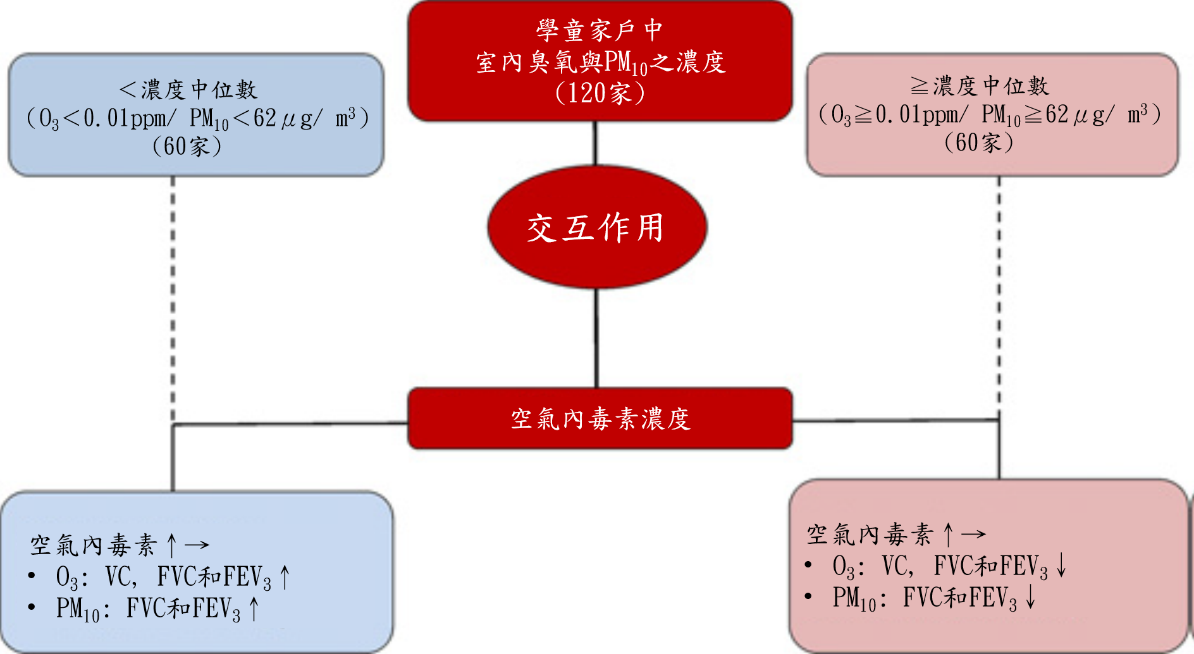
本校主要研究者之簡介:
陳培詩 研究員
研究聯繫Email:
pschen@kmu.edu.tw
期刊出處:
Science
of the Total Environment 705 (2020) 135810
研究全文下載:
https://www.sciencedirect.com/science/article/pii/S004896971935805X
Endotoxin is the constituent of the
cell wall of gram-negative bacteria that initiates the inflammatory response. Previous
studies showed consistent results that airborne endotoxin exposure may increase
the risk of respiratory symptoms in asthmatic children.
Moreover, previous studies displayed that the air pollutants- nitrogen dioxide
(NO2) and nicotine may modify the association between
airborne endotoxin and asthma outcome (acute visit, symptoms, etc.) and airway
inflammation (the fractional concentration of exhaled nitric oxide) in asthmatic
children.
So far, limited studies
have explored the effects of interactions between airborne endotoxin and air pollutants.
The team led by Pei-Shih Chen, the Chair of Public Health of Kaohsiung Medical University,
evaluated whether indoor air pollutants in a heavy industrial city, including
NO2, PM, the carbon monoxide (CO), carbon dioxide (CO2), sulfur dioxide (SO2),
and ozone (O3), can modify the association between indoor airborne endotoxin
and lung function. 120 elementary school-age children in Kaohsiung City, Taiwan
was recruited. Airborne endotoxin and air pollutants were collected for 24
hours in living rooms while schoolchildren’s lung function was measured. The
modification of air pollutants on the relationship between airborne endotoxin
and children’s lung function was estimated after adjusting the gender, age,
height, weight, and case-control status. The team in collaborating with
Epidemiology, Human Genetics, and Environmental Sciences, School of Public
Health, University of Texas Health Science Center at Houston, TX, United States,
found that household O3 and PM can modify the association between household
airborne endotoxin and lung functions. Our findings suggest that the
combination of higher concentrations of O3 or PM10 exposure and concomitant
indoor airborne endotoxin exposure may affect schoolchildren’s lung function in
a heavy industrial city. These findings also highlight the importance of
understanding the complexity of indoor exposures and their effects on lung
functions to develop effective approaches to environmental control. The results
have been published in the journal Science of the Total Environment .
Graphical
Abstract
Our
findings suggest that the combination of higher concentrations of O3 or PM10
exposure and concomitant indoor airborne endotoxin exposure may affect
schoolchildren’s lung function in a heavy industrial city.
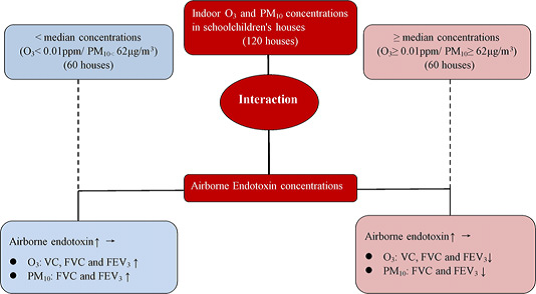
Main
researcher Intro.
Researcher
Pei-Shih Chen
Author
Email
pschen@kmu.edu.tw
Paper
cited from:
Science
of the Total Environment 705 (2020) 135810
Research
Paper available online on website
https://www.sciencedirect.com/science/article/pii/S004896971935805X
辛伐他汀透過保護粒線體對抗血管緊張素II所引發的心臟衰竭
在常見的心血管疾病包括「心臟衰竭」,通常伴隨著有粒線體功能障礙的情形。而羥甲基戊二酸單醯輔酶A還原酶(他汀類藥物)能夠抑制有害的氧自由基的產生,因此在慢性心臟衰竭中具有心臟保護作用。但是,他汀類藥物在心臟衰竭過程中是如何達到效果的? 以及對於心肌細胞內的能量提供的來源「粒線體」是否也有保護作用?這是我們研究團隊欲探索的項目。
透過心衰竭大鼠的動物實驗方式,我們團隊將大鼠分成: 1) 給予血管緊張素II(1.5 mg / kg /天/14天。2)予血管緊張素II合併給予辛伐他汀組(口服,10 mg/kg)經治療14天後在接下來的14天中停止給藥,終止實驗。
我們的研究成果發現:血管緊張素II會促進細胞內氧自由基的生成進而降低了粒線體的膜電位,導致粒線體的失能或是被破壞。然而透過給予辛伐他汀能夠有效地避免胞內氧自由基的生成進而維持了粒線體的膜電位使粒線體不致失能。而其中的關鍵在於辛伐他汀能夠在粒線體受損透過溶酶體將脂質油滴分解成脂肪酸產生能量,讓細胞有機會透過細胞自噬體來將受損的粒線體修復、或是移除。進而保護並維持細線體的功能,減緩心臟衰竭過程中對於心肌細胞的傷害。
圖形摘要
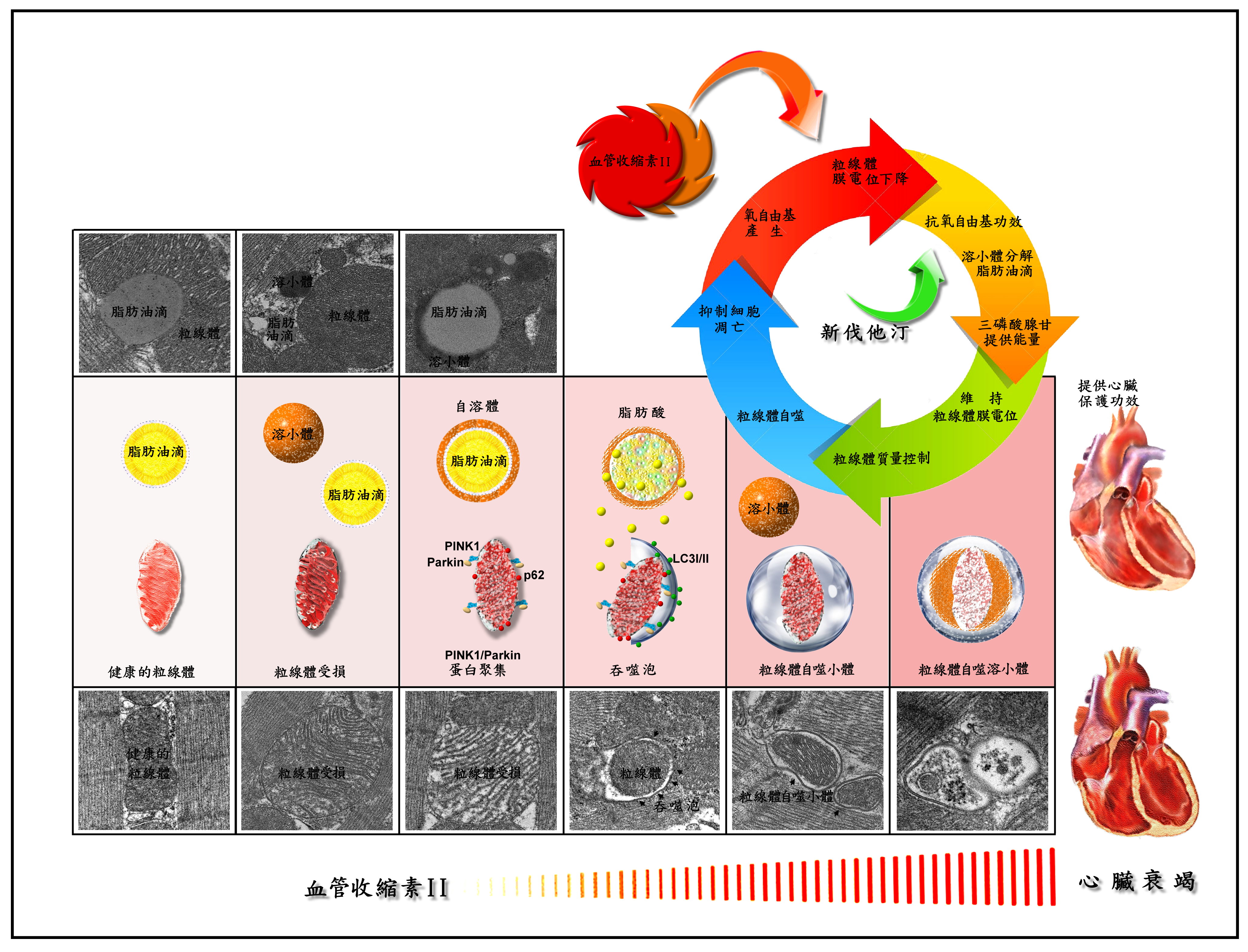
圖片說明: 血管緊張素II促進細胞內氧自由基的增加,降低了粒線體的膜電位,促使粒線體產生障礙無法提供心肌能量。透過給予辛伐他汀能夠有效地降低氧自由基並維持了粒線體的膜電位。同時辛伐他汀促進脂質油滴聚集於受損的粒腺體周圍並分解成脂肪酸提供粒線體透過自噬體的方式來自我修復,或是將無用的粒線體移除、進而維持細線體的功能減緩心臟衰竭對於心肌所帶來的傷害。
本篇為高雄醫學大學2019年月傑出論文10月份得獎文章,代表作者為醫學院呼吸治療學系劉博侖教授。
本校主要研究者之簡介:
論文第一作者為本校臨床醫學所博士班學生謝炯昭主治醫師,其為本校呼吸治療學系劉博侖教授所領導的團隊的一員。感謝科技部提供研究經費。
研究聯繫Email:
期刊出處:
British
Journal of Pharmacology. 2019
Oct;176(19):3791-3804.
期刊線上參閱網址:
Mitochondrial protection by
simvastatin against Angiotensin II-mediated heart failure
BACKGROUND AND PURPOSE
Mitochondrial dysfunction
plays a role in the progression of cardiovascular diseases including heart
failure. 3-Hydroxy-3-methylglutaryl-coenzyme A reductase inhibitors (statins),
which inhibit reactive oxygen species (ROS) synthesis, show cardioprotective
effects in chronic heart failure. However, the beneficial role of statins in
mitochondrial protection in heart failure remains unclear.
EXPERIMENTAL APPROACH
Rats
were treated with Angiotensin II (Ang II) (1.5 mg/kg/day) or co-administered
simvastatin (oral, 10 mg/kg) for 14 days; and then administration was stopped
for the following 14 days. Cardiac structure/function was examined by wheat
germ agglutinin staining and echocardiography. Mitochondrial morphology and the
numbers of lipid droplets, lysosomes, autophagosomes, and mitophagosomes were
determined by transmission electron microscopy. Human cardiomyocytes were
stimulated and intracellular ROS and mitochondrial membrane potential (ΔΨm)
changes were measured by flow cytometry and JC-1 staining, respectively.
Autophagy and mitophagy-related and mitochondria-regulated apoptotic proteins
were identified by immunohistochemistry and western blotting.
Graphical Abstract
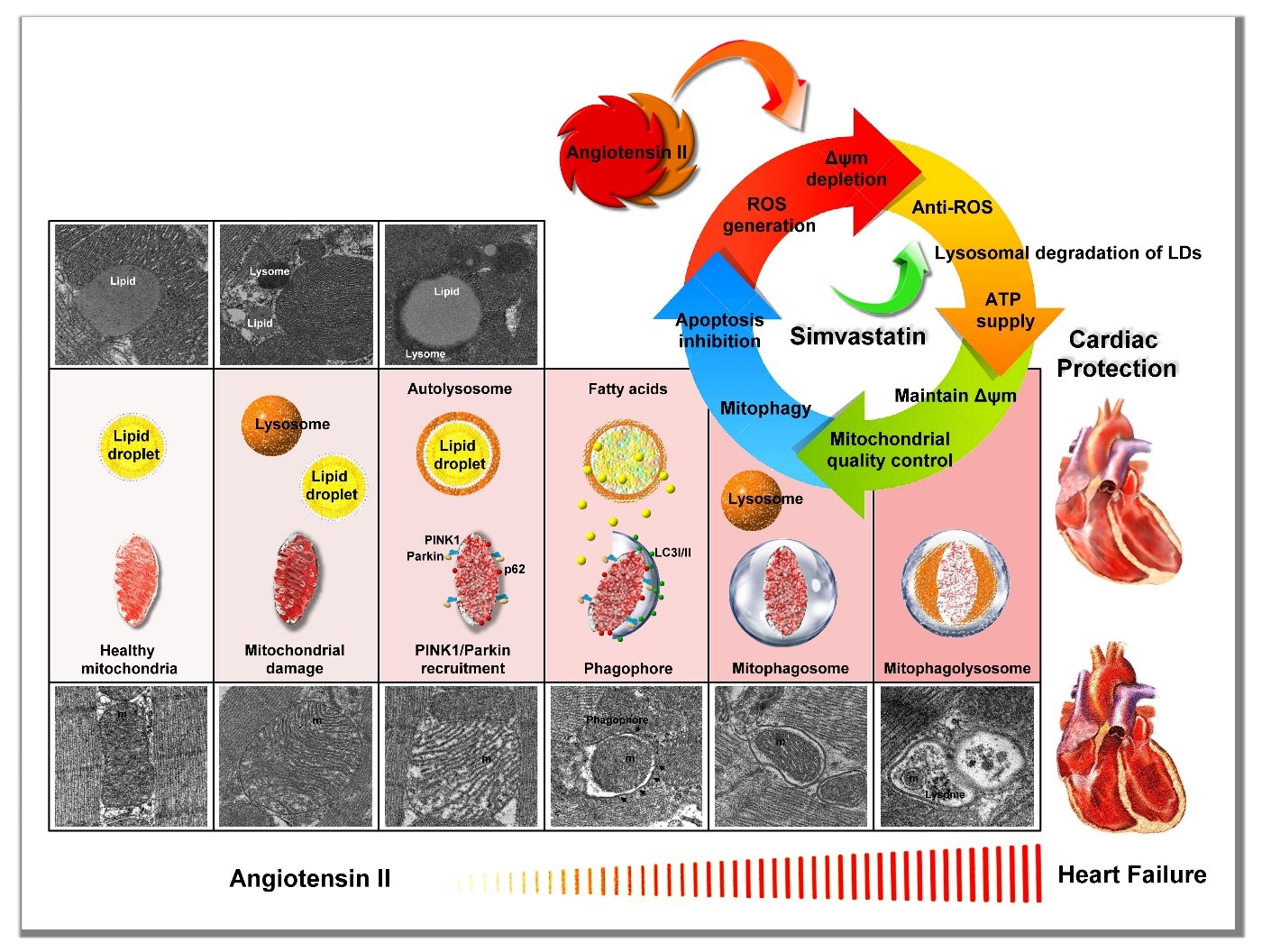
This
article-“Mitochondrial protection by simvastatin against angiotensin
II-mediated heart failure” , written by Rept. Author Professor Po-Len Liu
from Department of
Respiratory Therapy in College of Medicine,,
is presented for Kaohsiung Medical University 2019 Monthly Excellent Paper
Award in Oct.
Main researcher Intro.
Summary
scheme of the mitochondrial protection mechanism of simvastatin in Ang
II-induced HF. Simvastatin might reduce ROS generation, regulate LDs and
lysosome levels to provide energy to maintain ΔΨm, regulate
mitochondrial quality control to promote mitophagy, and prevent
mitochondrial-regulated apoptosis.
Researcher
The first author of the paper is the attending
physician Chong-Chao Hsieh, a student of the School of Clinical Medicine,
and a member of the team led by Professor Po-Len Liu of the Department of
Respiratory Therapy, College of Medicine, Kaohsiung Medical University. Thanks
to the Ministry of Science and Technology for providing research funding.
Author Email
Paper cited from:
Paper online website